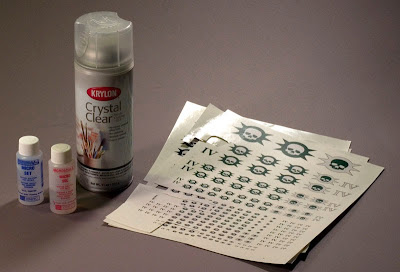con le decalcomanie ad acqua sarà un gioco!
Ciò di cui necessitate è :
- il contenitore (per decal singole è preferibile una forma cilindrica)
- Una stampante a getto di inchiostro o laser
- La carta decal idonea alla vostra stampante (seleziona carta da qui)
- Delle forbici od una taglierina
- Per chi usa stampa inkjet sarà necessario anche del fissativo trasparente.
Le seguenti istruzioni sono applicabili ad ambedue i tipi di carta.(clear & white INKJET)--- x la stampa laser non si ha bisogno di fissativo e quindi le fasi di questa guida nella quale se ne parla possono essere eluse.
Preparate il vostro lavoro grafico su pc.
Dimensionate ed impaginate a vostra preferenza
scegliendo la risoluzione idonea al vostro lavoro.
I fogli suppurtano risoluzione di stampa fino 2880 dpi.
Fate delle prove se non siete pratici, per l'impaginazione,
con dei fogli comuni e qualità bozza, tanto per vedere
se i margini delle foto \ immagini loghi siano corretti.
Quando siete sicuri stampate sul foglio decal su lato lucido.
Lasciate asciugare qualche minuto i fogli stampati.
Adesso dobbiamo fissare i colori di stampa poichè questi sono idrosolubili
e visto che per spellicolare la decal dobbiamo metterla in acqua
il processo di fissaggio è obbligatorio.
Per fissare i colori usiamo una comune bomboletta di spray trasparente lucido
vendute comunemente in ferramenta.In genere hanno dicitura :
SMALTO SINTETICO ACRILICO A RAPIDA ESSICAZIONE
-non ci sono per il momento preferenze di marca-
Per eseguire un lavoro pulito e corretto:
tenete il foglio in piano-mai con pendenza anche se minima,
lavorate e spruzzate in luogo idoneo ben areato e privo di polveri o pelurie,
accorgimento utile può essere dopo la stampa, passare sul foglio delicatamente
un panno acchiappapolvere antistatico-(li vendono nei negozi per la pulizia della casa).
procediamo con lo spruzzare il fissativo a mano leggera
distanza circa 30cm, il nostro foglio deve diventare omogeneamente bagnato di fissativo,(NON ESAGERATEe!!)
in controluce sembrarà completamente bagnato;
anche la minima zona non copertà correttamente può causare lo scioglimento del colore in essa.
Lasciamo asciugare
In genere questi fissativi asciugano in 15 min.
Io consiglio anche di attendere di più, a seconda dell'uso che se ne fà
possiamo prepararli in serie, e magari il giorno dopo avere tutti i fogli pronti e ben asciutti.
Credo sia buona norma non lasciare i fogli già fissati fermi per troppo tempo.
teniamo sempre in ogni caso i nostri fogli in luoghi asciutti, e mai con i lati lucidi
sovrapposti.
Il foglio è pronto, se sono più immagini o loghi sulla stampata dobbiamo ritagliarli,forbici o bisturi da carta,
una volta ritagliati ci occorre una bacinella e dell'acqua
mettiamo la carta in acqua.................
dopo circa 50 sec. il film della decal si separa dalla carta,
alcuni preferiscono prendere solo il film,
altri recuperano anche il sottofondo cartaceo per aiutarsi
nel far scivolare la decal sull'oggetto,
quì tutto dipende dalla pratica e dalla grandezza delle decal
lascio a voi appunto , la pratica.
Io ho notato che inumidendo l'oggetto sul quale devo posare la decal
questa scivolerà più facimente e sarà + agevolmente posizionata.



 Remove these ads by
Remove these ads by











































